Journal of
eISSN: 2373-633X


Case Report Volume 4 Issue 6
Department of Radiology & Imaging, DM Wayanad Institute of Medical Sciences, India
Correspondence: Krishna Kumar M, Associate Professor of Radiology, Department of Radiology & Imaging, DM Wayanad Institute of Medical Sciences, Naseera Nagar, Meppadi P.O: 673577, Wayanad, Kerala, India, Tel 8111881170
Received: April 19, 2016 | Published: May 17, 2016
Citation: Krishna KM. Retrobulbar bilateral optic nerve colobomatous cysts; MRI & CT imaging features. J Cancer Prev Curr Res. 2016;4(6):189-192. DOI: 10.15406/jcpcr.2016.04.00144
Colobomatous cyst of the orbit is a rare malformation associated with microphthalmic globe or asymmetrically large globe.Usually, it appears since birth without any sex predilection and can affect one globe or rarely both the globes. A coloboma is a gap or defect in the globe resulting from the failure of the choroidal fissure to close. A coloboma may be an isolated finding or a part of a complex syndrome. Orbital cystic lesions in childhood differ in their pathology and management. MRI & CT scan can demonstrate the anatomic relationship of the cyst to the globe, prior to surgical intervention as well as any associated developmental anomalies of the brain. We report an 11 year male child with bilateral retrobulbar optic nerve Colobomatous cyst, presenting with diminution of vision, evaluated clinically and radiologically by CT & MRI.
Keywords: coloboma, colobomatous cyst, computed tomography, magnetic resonace imaging, microphthalmia, optic nerve; orbital cystic lesion
USG, ultrasonography; FLAIR, fluid attenuation inversion recovery; CBC, complete blood count; LFT, liver function tests; RFT, renal function tests; CT, computed tomography; MRI, magnetic resonance imaging
Orbital cystic lesions are divided into congenital & acquired. Congenital retino-choroidal and optic nerve colobomas are conditions characterized by altered ocular tissue in one or more locations since birth. Coloboma (from the Greek koboboun, to mutilate), is defined as an absence or defect of some ocular tissue, usually resulting from malclosure of the fetal intraocular fissure, was first described by Walther in 1821.1
Ocular colobomas are thought to be secondary to defects in embryogenesis in which there is impaired closure of the optic fissures resulting in a defect in the cornea, lens, optic nerve, and/or uvea.2 In a typical Coloboma, the cleft appears in the infero-nasal quadrant of the globe and may involve optic disc, retina & choroid. Atypical colobomas may involve iris & lens.
Colobomatous cyst is a neuroectodermal-lined cyst that had been firstly described by Thomas Bartholin in 1673. The clinical presentation of this cyst ranges from undetectable cyst to a large protruding one, but the typical presentation is a protruding cyst in the infero-nasal quadrant of the eye associated with a microphthalmic globe.3,4 Developmental cysts of the orbit include dermoid cyst, epidermoid cyst, cephloceles, encephalocele, menigocele, menigoencephalocele, primary optic nerve sheath cyst, congenital cystic eye, dural ectasia & colobomatous cysts.
Acquired cysts of the orbit include lymphangiomas, lacrimal gland cysts, hematic cysts, epithelial/ appendage cysts, hydatid cysts, cysticercal cysts & mucocele. It is crucial to differentiate these lesions from each other because their treatment varies from observation to excision. Without correlation with clinical data and imaging, colobomatous cyst can be very easily misdiagnosed as malignancy because of its rarity and unusual microscopic features.3 The aim of this article was to describe CT & MRI findings of optic nerve colobomatous cysts.
We evaluated the radiological findings in an 11 year old male child presenting with bilateral diminution of vision, referred for computed tomography and magnetic resonance imaging of the orbits. On ophthalmic examination, both eye showed a deformed globe with reduced antero-posterior diameter and an attached cyst protruding from the posterior aspect of the globe. The blood tests including complete blood count (CBC), hemoglobin, liver function tests (LFT), and renal function tests (RFT) were all within normal limits.
Plain & Contrast Enhanced CT were obtained using a GE Light speed vCT 64 slice CT scanner after administration of 60 mL of omnipaque 350 (Iohexol) via automated antecubital venous infusion.
On plain & contrast CT examination (Figures 1 & 2) of bilateral orbits & brain, there was a small cystic lesion situated in the inferior compartment of the bilateral orbit without significant displacement of the globe. The cysts showed uniform thin walls and contrast enhancement. The cyst cavity was homogenous, with no internal contrast enhancement. The size of the cysts was about 12×14 mm. The globe was mildly reduced in size with reduced antero-posterior diameter. The brain was unremarkble. The MRI was performed using 1.5 T magnets (GE Medical Systems). Standard T1- and T2-weighted, Fluid attenuation inversion recovery (FLAIR), spin-echo & fast spin echo pulse sequences were used.
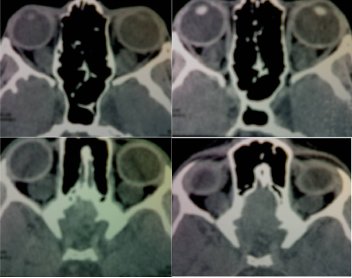
Figure 1 Axial (A-D) & Coronal (E-H) nonenhanced CT Orbit revealed oval hypodense bilateral retrobulbar cysts encasing optic nerves with mild bilateral microphthalmia.
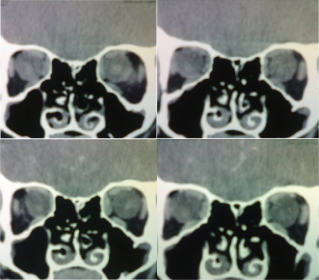
Figure 2 Contrast enhanced axial CT orbits revealed bilateral oval retrobulbar cysts with thin wall enhancement.
On MRI scan, there was a homogenous cystic lesion associated with small sized globe, occupying the retrobulbar region of both orbit (Figures 3–7). It measured around 12x14x11 mm in the antero-posterior, transverse and cranio-caudal dimensions. There was no solid component within the cyst. No areas of hemorrhage, calcification or any post-contrast enhancement within the cyst. Thin wall enhancement of the cysts noted. No obvious communication was present between the cyst and intracranial structures.

Figure 3 Axial (A,B) & Sagittal (C-D) T1 Weighted, MR images revealed bilateral mild microphthalmia with an oval hypointense cyst encasing optic nerves bilaterally.
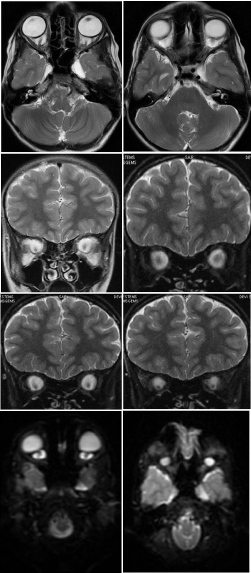
Figure 4 Axial (A,B), Coronal (C) & Coronal T2 Weighted fat saturated (D-F) images shows hyperintense oval retrobulabar cysts on either side with increased ADC values (G,H).
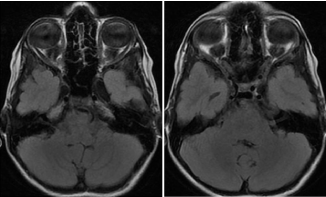
Figure 5 Axial (A,B) Fluid Attenuation Inversion Recovery (FLAIR), images reveal bilateral oval retrobulbar hypointense cysts surrounding optic nerves.
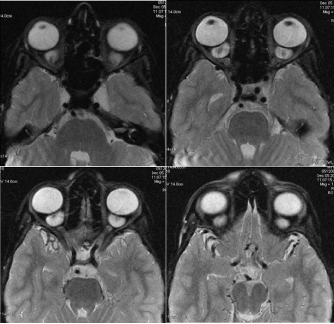
Figure 6 T2 Weighted Gradient MRI images (A-D) exhibited good resolution of the retrobulbar cysts surrounding optic nerves with no internal blooming.

Figure 7 T1 Weighted Contrast enhanced axial (A,B), coronal (C,D) and sagittal (E-H) reveal bilateral oval hypointense retrobulbar cysts with thin wall enhancement.
T2 weighted images (Figure 4) show bilateral hyperintense to vitreous cystic lesions with increased ADC values and iso to hypointense to vitreous on T1W (Figure 3) & FLAIR (Figure 5) images in the intraconal retrobulbar location, encasing optic nerves. Communication of the cysts through a defect in the posterior part of the globes was suspected, though it was not clearly demonstrated. Based on the clinical & imaging findings, the child was diagnosed as a case of bilateral colobomatous cyst with suspicious communication into the both globes. No obvious pathology was noticed in the brain. No associated malformations detected. The child underwent an inferior transconjuctival orbitotomy with aspiration of the contents of the cyst to reduce its volume, followed by excision of the cyst. Histopathology of the cyst revealed the outer wall consisting of dense fibro-collagenous tissue with inner wall lined with glial tissue suggestive of colobomatous cysts.
Abnormal closure of the fetal optic fissure along the eye and optic nerve results in a malformation of the eye termed ocular coloboma, consisting of localized defects in the uvea, retina and optic nerve. Variability in the position and size of the defects, leads to a spectrum of deformities. According to Shields classification of orbital cysts of childhood, colobomatous cyst was classified as “a cyst of neural tissue related to ocular maldevelopment”.3 The condition can occur in association with multiple congenital abnormalities indicative of an insult to the developing fetus during the sixth week of gestation.5
Optic nerve coloboma may occur sporadically or be inherited with an autosomal dominant inheritance.6 The etiology of the failure of closure of the optic fissure is largely unknown. Genetics such as PAX2 and PAX6, and teratogenic agents may play a role in the causation.7 It can affect any part of the globe and may lead to the retrobulbar herniation of vitreous fluid.8,9 Colobomas can be unilateral or bilateral and range from small defects in the posterior aspect of the globe to large retrobulbar cystic masses. Microphthalmos is usually present, although the defect might create an asymmetrically large globe.8 It usually presents at birth3 but can be detected even antenatally by ultrasound.10
Clinically child may present with varying degrees of reduced visual acuity. Careful analysis of the photographic appearances of colobomata involving the optic nerve has shown that the only feature that relates to visual outcome is the degree of foveal involvement by the coloboma. Significant refractive error and anisometropia are common.11
The “morning glory syndrome” is a congenital optic disc dysplasia in which a conical excavation of the posterior fundus includes the optic disc and is filled with glial tissue, whose fundoscopic appearance is similar to that of a flower called morning glory.12
Optic disc colobomata may have a wide range of associations which include-CHARGE association (coloboma, choanal atresia, congenital heart disease, and multiple other abnormalities), Walker-Warburg syndrome, Goltz focal dermal hypoplasia, Aicardi syndrome, Goldenhar syndrome, and linear sebaceous naevus syndrome.13
Colobomas may be associated with optic nerve atrophy and have been reported in association with transsphenoidal encephaloceles, olfactory dysplasia, and agenesis of the corpus callosum.9 Retinal detachment is a well-recognized risk in the setting of coloboma and occurred in up to 40% of eyes with coloboma.14 Foxman et al.,15 reported that bilateral microphthalmos with colobomatous cyst may be associated with major systemic abnormalities (central nervous system, renal, or cardiovascular), whereas unilateral involvementis usually associated with minor abnormalities.
Our patient was unusual because he had bilateral colobomatous cystic disease with microphthalmia but no associated systemic abnormalities. Imaging modalities such as A- scan and B- scan Ultrasonography (USG), Computed Tomography (CT) and Magnetic Resonance Imaging (MRI) are helpful in supporting the diagnosis and in differentiating it from other cystic lesions & tumors.
CT scan can show an intraconal cystic mass closely associated with the posterior aspect of the globe.9,16 CT is helpful in demonstrating the extent of the cysts and differentiating them from other intraorbital masses. It is also useful in evaluating the effect of cyst decompressions and recurrences. On MRI, cystic contents usually exhibit simple fluid signal intensity. Microphthalmos is usually present, although the defect might create an asymmetrically large globe.8 Colobomas may also be diagnosed prenatally using fetal MRI.17
While some of these cysts spontaneously regress, others continue to grow causing some complications. Some believe that their growth is due to the accumulation of the fluids within the cyst. Others think that the proliferation of the glial tissue may be a factor in their enlargement.18,19 In some cases a communication between the cyst and the subarachnoidal space has been thought to be responsible for continuous cyst enlargement. In most cases, however, no communication could be demonstrated despite enlargement of the cyst.
Management of the colobomatous cysts depends on the age of the patient, the size of the cyst, the presence of communication between the globe and the cyst, and the visual prognosis.20 The initial approach for these patients was observation, although surgery may be necessary for some patients. However, if the cyst became enlarged over time, repeated aspiration of the cyst can be a successful management approach and can be performed with minimal distress to the patient.
Kodama et al.,21 also reported success with repeated aspiration in patients and recommend that aspiration is considered for patients with extreme colobomatous orbital cyst to maximize the development of the bony orbit. Our patient also underwent aspiration of the contents of the cyst to reduce its volume, followed by excision of the cyst. The constellation of clinical features, imaging and histopathological characteristics in our case was diagnostic of colobomatous cyst.
Colobomatous cyst is a rare, developmental anomaly of the globe that results from a defect in closure of the embryonic fissure, during the 6-7th weeks of gestation. Usually, the cyst is associated with a microphthalmic globe or asymmetrically large globe. Correlation with the clinical presentation and imaging is imperative to reach the accurate diagnosis. In the pediatric population, cross-sectional imaging with CT and MRI plays a prime role in differentiating these lesions from other tumors and other cystic lesions.
Management varies from simple aspiration of the cyst, enucleation of the microphthalmic eye along with the cyst, and excision of the cyst with preservation of the globe depending on the age of the patient and size of cyst.
None.
The author declares that there is no conflict of interest.
None.

©2016 Krishna. This is an open access article distributed under the terms of the, which permits unrestricted use, distribution, and build upon your work non-commercially.